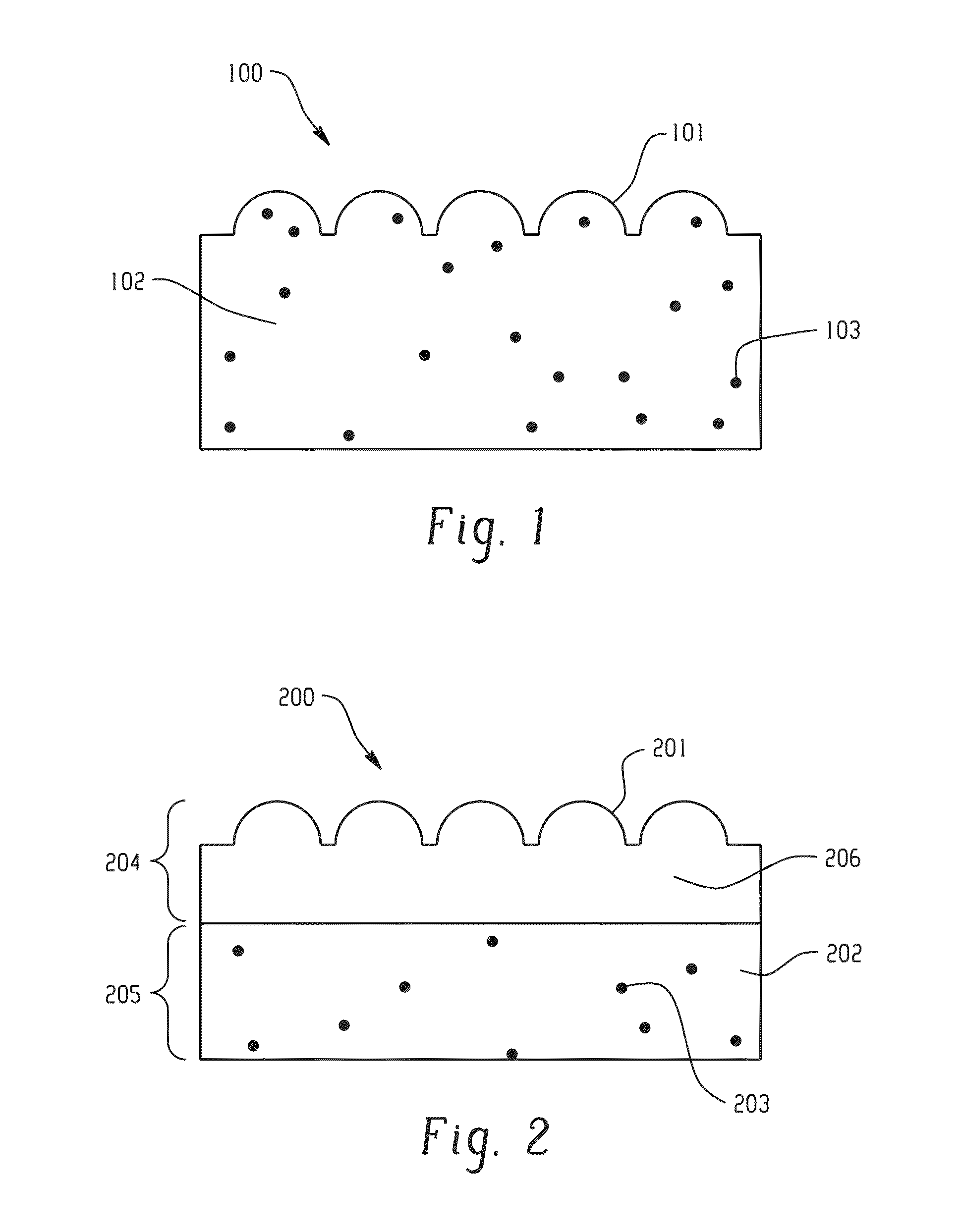Sheet for LED light cover application
a technology of led light cover and polymer sheet, which is applied in the field of polymeric sheet, can solve the problems of limited improvement, high cost of light transmission, and difficulty in obtaining balanced hiding power and light transmission
- Summary
- Abstract
- Description
- Claims
- Application Information
AI Technical Summary
Benefits of technology
Problems solved by technology
Method used
Image
Examples
example 1
[0038]Polycarbonate (PC) resin loaded with 0.6 wt % of a cross-linked PMMA was fed to a calendar extrusion system for monolithic extrusion. In the extrusion system, the nip roller stack used for calendaring extrusion line comprised of a master roller and a steel roller where the master roller had a ceramic surface engraved with microlens textures comprising lens units having diameters of about 100 micrometers. The thickness of the final sheet product was 1 millimeter (mm).
[0039]Offline test results show that the average aspect ratio of the microlens was 0.24. The light transmission and the DLD of the monolithic sheet were 90.5% and 13.3° respectively. In comparison, a 1 mm monolithic extruded sheet made from the same material but without any surface texture had a light transmission of 89.4% with almost no hiding power (DLD was 2.8°).
example 2
[0040]PC resin loaded with 0.2 wt % of silicone beads and PC resin without any dispersing particles (clear PC) were co-extruded in the extrusion system described in Example 1. The flow rates of the PC resin and the clear PC were controlled so that the thickness of the clear PC layer in the final sheet was around 0.05 mm and the total thickness of the sheet was 1 millimeter. The microlens texture was formed on the layer of clear PC.
[0041]Offline test results show that the average aspect ratio of the microlens was 0.22. The two-layered sheet had light transmission and DLD of 88.0% and 14.9° respectively. In comparison, a two-layered sheet having the same thickness and made of same materials for the PC and clear PC layers, but without any surface texture, had light transmission of 85.9% with almost no hiding power (DLD was 1.3°).
example 3
[0042]This example illustrates the synergy of hiding power achieved by combining microlens structures and light diffusing particles in a sheet.
[0043]Four sheets, labeled as “Diffuser only”, “Microlens only”, “Diffuser and Microlens (monolithic sheet)” and “Diffuser and Microlens (coextruded sheet)” as shown in Table 1, were made according to the processes described in Examples 1 and 2.
[0044]
TABLE 1Diffuser andDiffuser andDiffuser onlyMicrolens onlyMicrolensMicrolensTest Item(comparative)(comparative)(monolithic sheet)(coextruded sheet)Light diffusing0.4 wt % ofnone0.4 wt % of0.4 wt % of siliconeparticlessilicone beadssilicone beadsbeadsSurface TexturenonemicrolensmicrolensmicrolensTotal thickness0.8 mm0.8 mm0.8 mm0.8 mmof the sheet
[0045]Hiding power was measured by DLD method and visual check in real LED light box. The test results are shown in Table 2. The results indicate that the DLD values of “Diffuser Only” and “Microlens Only” samples were very low (1.5° and 6.1° respectively)...
PUM
 Login to View More
Login to View More Abstract
Description
Claims
Application Information
 Login to View More
Login to View More - R&D
- Intellectual Property
- Life Sciences
- Materials
- Tech Scout
- Unparalleled Data Quality
- Higher Quality Content
- 60% Fewer Hallucinations
Browse by: Latest US Patents, China's latest patents, Technical Efficacy Thesaurus, Application Domain, Technology Topic, Popular Technical Reports.
© 2025 PatSnap. All rights reserved.Legal|Privacy policy|Modern Slavery Act Transparency Statement|Sitemap|About US| Contact US: help@patsnap.com



